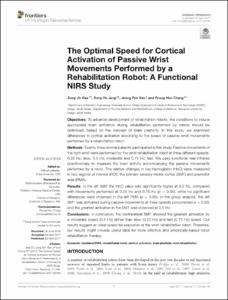Full metadata record
| DC Field | Value | Language |
|---|---|---|
| dc.contributor.author | Bae, Sung Jin | - |
| dc.contributor.author | Jang, Sung Ho | - |
| dc.contributor.author | Seo, Jeong Pyo | - |
| dc.contributor.author | Chang, Pyung Hun | - |
| dc.date.available | 2017-08-10T08:19:05Z | - |
| dc.date.created | 2017-08-09 | - |
| dc.date.issued | 2017-04 | - |
| dc.identifier.issn | 1662-5161 | - |
| dc.identifier.uri | http://hdl.handle.net/20.500.11750/4265 | - |
| dc.description.abstract | Objectives: To advance development of rehabilitation robots, the conditions to induce appropriate brain activation during rehabilitation performed by robots should be optimized, based on the concept of brain plasticity. In this study, we examined differences in cortical activation according to the speed of passive wrist movements performed by a rehabilitation robot. Methods: Twenty three normal subjects participated in this study. Passive movements of the right wrist were performed by the wrist rehabilitation robot at three different speeds: 0.25 Hz; slow, 0.5 Hz; moderate and 0.75 Hz; fast. We used functional near-infrared spectroscopy to measure the brain activity accompanying the passive movements performed by a robot. The relative changes in oxy-hemoglobin (HbO) were measured in two regions of interest (ROI): the primary sensory-motor cortex (SM1) and premotor area (PMA). Results: In the left SM1 the HbO value was significantly higher at 0.5 Hz, compared with movements performed at 0.25 Hz and 0.75 Hz (p < 0.05), while no significant differences were observed in the left PMA (p > 0.05). In the group analysis, the left SM1 was activated during passive movements at three speeds (uncorrected p < 0.05) and the greatest activation in the SM1 was observed at 0.5 Hz. Conclusions: In conclusion, the contralateral SM1 showed the greatest activation by a moderate speed (0.5 Hz) rather than slow (0.25 Hz) and fast (0.75 Hz) speed. Our results suggest an ideal speed for execution of the wrist rehabilitation robot. Therefore, our results might provide useful data for more effective and empirically-based robot rehabilitation therapy. © 2017 Bae, Jang, Seo and Chang. | - |
| dc.language | English | - |
| dc.publisher | Frontiers Media S. A | - |
| dc.title | The Optimal Speed for Cortical Activation of Passive Wrist Movements Performed by a Rehabilitation Robot: A Functional NIRS Study | - |
| dc.type | Article | - |
| dc.identifier.doi | 10.3389/fnhum.2017.00194 | - |
| dc.identifier.scopusid | 2-s2.0-85018366197 | - |
| dc.identifier.bibliographicCitation | Frontiers in Human Neuroscience, v.11 | - |
| dc.description.isOpenAccess | TRUE | - |
| dc.citation.title | Frontiers in Human Neuroscience | - |
| dc.citation.volume | 11 | - |
- Files in This Item:
-
 기타 데이터 / 1.25 MB / Adobe PDF
download
기타 데이터 / 1.25 MB / Adobe PDF
download
- Appears in Collections:
- ETC 1. Journal Articles



